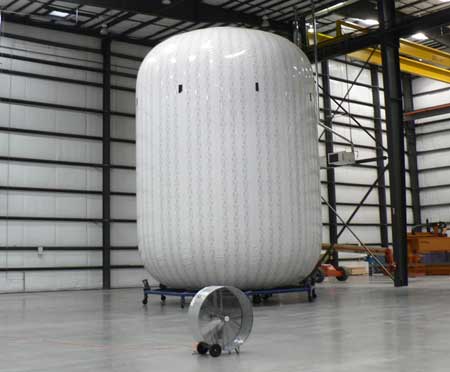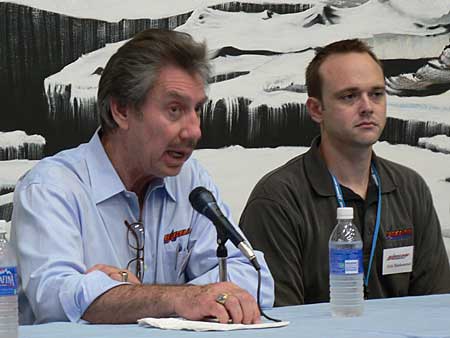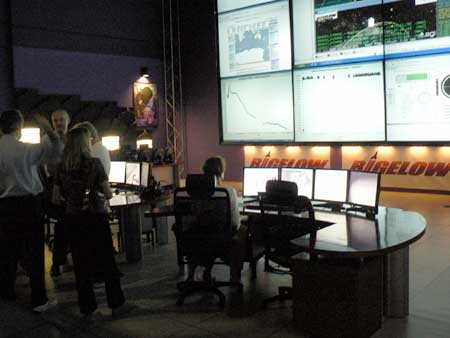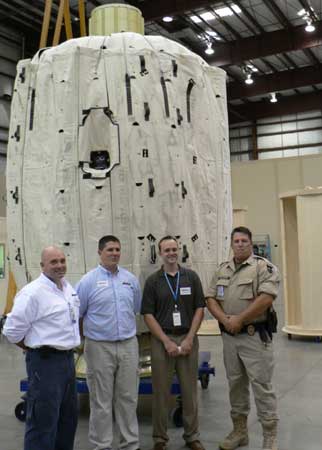It was probably inevitable that someone would speak out against Space Adventures’ announcement Friday that it will offer spacewalks as an option for its orbital tourists. While a number of former NASA spacewalkers who advise the company have endorsed the plan, former astronaut Jerry Linenger, who performed an EVA during his stay on the Mir space station in 1997, told the AP he thinks allowing tourists to perform spacewalks is a bad idea. The article is scant on details, although Linenger is quoted as saying that “common sense” makes it clear that only “highly-trained professionals” (in the article’s, not Linenger’s, words) should perform EVAs, and that a tourist on a spacewalk could endanger the life of the cosmonaut he would outside the station with.
|
||||||
|
In just under three months the X Prize Cup will take place in Las Cruces, New Mexico. However, so far there have been few confirmed details about what is going on. The X Prize Foundation had planned to unveil more details on a revamped web site last month, but as of Saturday morning the site’s splash page now states that the new site will launch on Monday the 24th (this after the June date was still posted on the site as recently as earlier this month.) One of the highlights of the event is going to be the Lunar Lander Challenge, and the two companies most likely to compete, Armadillo Aerospace and Masten Space Systems, provided some updates on their progress yesterday at the NewSpace 2006 conference in Las Vegas. Neil Milburn of Armadillo said that their first “Quad” vehicle is built and ready for testing, while a second is being built. (One will be flown for the Level 1 of the challenge, while the second will be used for the more challenging Level 2.) The Quad replaced their Vertical Drag Racer design, which Milburn said was “marginal” for the Level 2 portion of the challenge. Dave Masten of Masten Space Systems said that they are very busy with the development of their entry, the XA-0.1, and plan to start flight testing next week in Mojave. It’s not clear if there are any other entrants likely to compete in Las Cruces in October, although there have been rumors of one or more stealth teams working on vehicles; if that’s true, they’re being very quiet about it. Both of the known entrants are going to have to overcome some significant technical and regulatory hurdles in the next three months, and any stumble that forces one or both to drop out could make the Lunar Lander Challenge a lot less compelling an event. There’s also news of a separate event around the same time as the X Prize Cup. According to a report by SyFy Portal, the ashes of the late Star Trek actor James Doohan and astronaut Gordon Cooper, among others, will be launched on a suborbital sounding rocket flight from Spaceport America on October 21, the second day of the Cup. The launch is being conducted by UP Aerospace for Space Services International (SSI) (of Celestis fame). According to SSI’s web site the launch appears to be open only to family members and other Celestis “registrants”, and not the general public, although the public will be invited to a memorial service the day before, according to the SyFy Portal article. It’s not clear from the article if there will be, say, a live broadcast of the launch for XP Cup attendees or other cooperation between the Cup organizers and SSI/UP Aerospace. A day after a visit to Bigelow Aerospace’s corporate headquarters to interview Robert Bigelow, myself and a number of other reporters traveled up to the company’s manufacturing facility in an industrial park in North Las Vegas (with a spectacular view of the Las Vegas skyline) for a press conference and tour. At the press conference, Robert Bigelow and six other company employees, including project manager Eric Haakonstad, entertained questions for an hour about Genesis 1 and the company in general. A lot of the questions covered the same ground I did with Bigelow himself yesterday; MSNBC’s Alan Boyle has an excellent summary, with photos, of the event. (While those on a separate tour of the plant organized by the Space Frontier Foundation could not take photos, reporters on a separate tour could, albeit with significant restrictions, as Alan discussed in his Cosmic Log account.) Here are a few photos of my own from the event:  A full-scale mockup of the pressure vessle of the full-sized module Bigelow is developing.  Robert Bigelow and project manager Eric Haakonstad at the press conference.  A view inside the mission control center for Genesis-1. The modern facility, with giant video screens on two walls, was completed just last month.  Several members of Genesis 1 team, as well as one of the ubiquitous (but friendly) security guards, pose in front a full-sized mockup of Genesis 1. Astronauts who have performed EVAs have routinely stated that their spacewalks have been the highlights of their trips to space, giving them a sense of freedom not possible by simply flying inside a spacecraft. Now, space tourists with a little extra spending money (okay, a lot of extra spending money) can share in that experience. The New York Times reported today (and Space Adventures has since confirmed) that the company will offer tourists the option of performing an EVA during their flights for an extra $15 million. Roskosmos, the Russian space agency, has signed off on the plan, with agency officials claiming that tourists with the right “physical and psychological capabilities” could require just an additional month of training to undertake the EVA. The spacewalks would last up to 90 minutes; by comparison, typical spacewalks by shuttle and station crew members last six to seven hours. The EVA also, according to Space Adventures, “would lengthen the mission approximately six to eight days”; it’s not clear if they mean extending the mission from six to eight days (a two-day extension), which could be accommodated with the regular Soyuz taxi flight schedules, or a week-long extension, which would require changes in the overall schedule for such taxi missions. Virgin Galactic has a vehicle under development, a group of 100 Founders that have paid to be the first to fly on the vehicle, and a list of tens of thousands of people who have expressed an interest in flying at some point. So it’s a little surprising to see that Virgin has put a call for travel agents to help sell their flights. The “Virgin Galactic Space Agents” will be existing registered travel agents who will book flights on SpaceShipTwo for suborbital tourists. Prospective “space agents” have to demonstrate to Virgin skills like “managing your client expectations” and “excellent customer service”, as well as how they would go about drumming up business for Virgin. This is an intriguing move since, to date, Virgin Galactic has appeared effective in rounding up customers on its own, thanks in large to the publicity it has generated. Perhaps the company is thinking ahead to a time when there will be more competition for suborbital space tourism flights and Virgin will need more than the Branson publicity machine to keep up sales? The European Space Agency (ESA) is taking a small step to promote the development of a European space tourism industry through a small-scale initiative announced Thursday. The “The Survey of European Privately-funded Vehicles for Commercial Human Spaceflight” will allow European companies planning vehicles intended to serve the space tourism market to submit proposals through ESA’s General Studies Program; three of the companies will receive awards of up to €150,000 (US$190,000) to further develop their plans. “The aim of the study will be to critically review the spacecraft design and mission profiles, ensuring they are technically feasible, and develop sound business plans in order to allow companies to approach potential investors,” the ESA study notes. Given that there hasn’t been too much vehicle development activity in Europe to date that has been focused on space tourism (former X Prize contenders like Starchaser and Bristol Spaceplanes in the UK and ARCA in Romania), one wonders if this project will stimulate some new plans on the continent. When most people arrive in Las Vegas, they make a beeline for the casinos. Me, I went in a different direction (literally and figuratively), paying a visit to the corporate headquarters of Bigelow Aerospace in Las Vegas. (This is a separate location from their manufacturing facility in North Las Vegas.) I spent over an hour there interviewing Robert Bigelow about Genesis 1, the company’s future plans, and related issues. All this will appear in an article (or two) in future issues of The Space Review, but here are a few highlights:
There’s a lot more to the interview than these notes, so stay tuned for more in the days to come. I’ll be travelling to Las Vegas later today to attend the NewSpace 2006 conference run by the Space Frontier Foundation, as well as some other activities. Some space tourism-related highlights of the upcoming conference:
If you’re at the conference, be sure to say hi. Many readers are already familiar with the “first honeymooners in space”, George Whitesides and Loretta Hidalgo, who are among Virgin Galactic’s founders. However, a couple plans to one-up them by getting married in space, The Times of Northwest Indiana reports. Cindy Cashman and Mitch Walling are planning to tie the knot on a Rocketplane XP suborbital flight in 2008. The couple even has a web site titled “First Space Wedding”. (Some might quibble with the “first” part, since A Russian cosmonaut on the ISS got married to his Earthbound bride three years ago; Rocketplane appears to have covered that by “guaranteeing her the option to be the first bride to be married in space.”) Why she came up with the idea wasn’t mentioned in the article. However, at least we know what she can wear for the ceremony. When the news about the renaming of the Southwest Regional Spaceport as Spaceport America was first reported by the AP, a logo that featured the spaceport name superimposed on the classic Apollo 17 image of the Earth. However, the Spaceport America web site shows a slightly different logo: in this case, replacing the Apollo 17 Earth image with what appears to be a computer-generated view of the Western Hemisphere. The latter is arguably a more appropriate choice for Spaceport America, although the mixed messages are a little confusing. Speaking of the spaceport, Albuquerque Tribune columnist Gene Grant says he’s “getting warm on this spaceport idea”, and even likes the new name. “Calling itself the nation’s spaceport from the go is cheeky by half, and I love it. That’s the attitude I’m looking for.” |
||||||
| Copyright © 2025 NewSpace Journal - All Rights Reserved | ||||||

Recent Comments